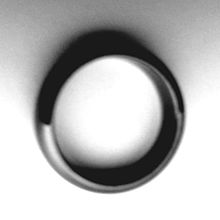Asexuality
[8][9] Asexuality is distinct from abstention from sexual activity and from celibacy,[10][11] which are behavioral and generally motivated by factors such as an individual's personal, social, or religious beliefs.
[38] Further empirical data about an asexual demographic appeared in 1994 when a research team in the United Kingdom carried out a comprehensive survey of 18,876 British residents, spurred by the need for sexual information in the wake of the AIDS pandemic.
[17][41] Contrasting Bogaert's 1% figure, a study by Aicken et al., published in 2013, suggests that, based on Natsal-2 data from 2000 to 2001, the prevalence of asexuality in Britain is only 0.4% for the age range 16–44.
[50] The first study that gave empirical data about asexuals was published in 1983 by Paula Nurius concerning the relationship between sexual orientation and mental health.
[51] 689 subjects—most of whom were students at various universities in the United States taking psychology or sociology classes—were given several surveys, including four clinical well-being scales.
[51][52] In a 2013 study, Yule et al. looked into mental health variances between Caucasian heterosexuals, homosexuals, bisexuals, and asexuals.
In a 2016 analysis in the Archives of Sexual Behavior, Brotto et al. found "only weak support" for this criterion being met among asexual individuals.
[63] Storms conjectured that many researchers following Kinsey's model could be mis-categorizing asexual subjects as bisexual, because both were simply defined by a lack of preference for gender in sexual partners.
[64][65] In a 1983 study by Paula Nurius, which included 689 subjects (most of whom were students at various universities in the United States taking psychology or sociology classes), the two-dimensional fantasizing and eroticism scale was used to measure sexual orientation.
Notable researchers who have produced significant works in asexuality studies include KJ Cerankowski, Ela Przybylo, and CJ DeLuzio Chasin.
[66] Cerankowski and Milks have suggested that asexuality raises many more questions than it resolves, such as how a person could abstain from having sex, which is generally accepted by society to be the most basic of instincts.
Three men living in Southern Ontario, Canada, were interviewed in 2011, and Przybylo admits that the small sample size means that her findings cannot be generalized to a greater population in terms of representation and that they are "exploratory and provisional", especially in a field that is still lacking in theorizations.
Pryzyblo argues that asexuality is made possible only through the Western context of "sexual, coital, and heterosexual imperatives".
[70] She addresses earlier works by Dana Densmore, Valerie Solanas, and Breanne Fahs, who argued for "asexuality and celibacy" as radical feminist political strategies against patriarchy.
[70] While Przybylo does make some distinctions between asexuality and celibacy, she considers blurring the lines between the two to be productive for a feminist understanding of the topic.
Chasin states that asexuality has the power to challenge commonplace discourse of the naturalness of sexuality, but that the unquestioned acceptance of its current definition does not allow for this.
Chasin also argues there and elsewhere in Making Sense in and of the Asexual Community: Navigating Relationships and Identities in a Context of Resistance that it is important to interrogate why someone might be distressed about low sexual desire.
[30] Scholar Ianna Hawkins Owen writes, "Studies of race have revealed the deployment of asexuality in the dominant discourse as an ideal sexual behavior to justify both the empowerment of whites and the subordination of blacks to uphold a racialized social and political system.
[73] This is co-existent with the sexualization of black female bodies in the Jezebel archetype, both utilized to justify slavery and enable further control.
[75][76] Karen Cuthbert comments on "providing the first empirically grounded discussion of this intersection of asexuality and disability (and to a lesser extent gender and 'race').
[81] Kurowicka argues that contemporary discourses should trouble the desire to separate asexuality and disability that is rooted in compulsory sexuality.
[43] In an earlier 2006 article, Bogaert acknowledges that a distinction between behavior and attraction has been accepted into recent conceptualizations of sexual orientation, which aids in positioning asexuality as such.
[85] Several small communities existed online, such as the "Leather Spinsters", "Nonolibidoism Society", and "Haven for the Human Amoeba", documented by Volkmar Sigusch.
[89] The flag's colors—four horizontal stripes of black, gray, white, and purple from top to bottom—represent asexuality, gray-asexuality, allosexuality, and community, respectively.
[100] The intention for the day is "to place a special emphasis on the international community, going beyond the anglophone and Western sphere that has so far had the most coverage".
Since 1999, Brazil has banned pathologization or attempted treatment of sexual orientation by mental health professionals through the national ethical code,[132] and the U.S. state of New York has labeled asexuals as a protected class.
[133] However, asexuality does not typically attract the attention of the public or major scrutiny; therefore, it has not been the subject of legislation as much as other sexual orientations have.
[135] Sir Arthur Conan Doyle portrayed his character Sherlock Holmes as what would today be classified as asexual,[120] with the intention to characterize him as solely driven by intellect and immune to the desires of the flesh.
[120] Films and television shows frequently feature attractive, but seemingly asexual, female characters who are "converted" to heterosexuality by the male protagonist by the end of the production.
[120] Asexuality as a sexual identity, rather than as a biological entity, became more widely discussed in the media in the beginning of the twenty-first century.










